Causes of abnormal appearance of pellets of granulator
Posted by Animall Feed Blok Making Machine | updatetime 2020-07-15 14:10
Causes of abnormal appearance of pellets of granulator
In the production of pellets for granulators, pellets with abnormal appearance may sometimes appear. Experienced manufacturers will know the reason for this situation and can quickly eliminate them. For inexperienced or new manufacturers, it is said that sometimes the crux of the problem cannot be found, and only the outside world or the granulator manufacturer's help is required. T he following are the reasons and improvement methods of seven xommon granules with abnormal appearance. This is a summary of the author's work experience in granulator development and debugging for many years, for comparison and referance in production.
1. The pellet is curved and has many cracks on one side
This phenomenon is usually generated when the pellets leave the ring die. In production, when the position of the cutter is adjusted far away from the surface of the ring die and the blade is blunt, when the particles are extruded from the die hole, they are broken or torn by the cutter instead of being cut. At this time, some particles are bent many cracks appeared on one side and on the other side. This kind of granular material often breaks from these cracks during cooling or transportation into the cooler, resulting in too much granular powder produced.
Improvement methods:
A) Increase the compression force of the ring die on the feed, that is, increase the compression ratio of the ring die, thereby increasing the density and hardness value of the pellets;
B) Crush the raw materials finer. If molasses or fat is added, the uniformity of the molasses or fat dispersion should be improved and the amount added should be controlled to increase the densty of the pellets and prevents the feed from becoming soft;
C) Adjust the distance of the cutting knife from the surface of the ring die, usually the distance of the knife edge from the outer surface of the ring die is not greater than the diameter value of the produced particles, or replace with a sharper cutting blade, and use a thinner for small diameter particles blade, and make the thin blade close to the surface of the ring die to produce;
D) The use of adhesive granulation aids helps to improve the brinding force inside the granules.
2. Horizontal cracks across the entire pellet
It is somewhat similar to the phenomenon in case 1. The crack accurred on the cross-section of the particle, but the particle did not bend. This can happen when fluffy granules containing more fibers are granulated. This kind of granular material is often when the feed is squeezed into the granulation hole of the ring die, because it contains fibers that are longer than the ore diameter, when the particles are extruded, due to the expansion effect of he fiber, the granule material produces transverse crucks in the cross section, producting a fiber-like appearance.
The improvement methods is to increase the compression force of the ring die on the raw material, that is, to increase the compression ratio of the ring die; to control the crushing fineness of the fiber, its maximum length cannot exceed one third of the particle size; reduce the output to reduce the raw material though the die hole speed, increase the compactness; lengthen the time of condition, use multi-layer conditioner or kettle type conditioner; when the water content of the powder is too high or contains urea, it may also produce the appearance of fir bark-like raw materials, should control the added water and urea content.
3. Vertical cracks in pellets
Some feed formulas contain fluffy and slightly elastic raw materials. This raw material will absord water and expand when it is tempered by the conditioner. After being compressed and granulated by the ring mold, it will be due to the effect of moisture and the raw material itself. Elastic and bounce off, creating a vertical crack.
The improvement method is: change the formula, but this may increase the cost of raw materials; control the quality of steam used during conditioning, try to use more saturated dry steam, so as to minimize the added moisture; reduce production or increase the effective length of the die hold to increase the time that the feed stays in the die hole as much as possible; adding a brinder also helps reduce the occurrence of vertical cracks.
4. The granular material produces a radial crack from a source point
This appearance shows that the granules contain large granular raw materials. When these large granular raw materials are tempered, it is difficult to fully absorb the moisture and heat in the steam. Unlike other finer raw materials, they are easily softened and cooled. At this time, due to the different degrees of softening, the difference in shrinkage is caused,resulting in radiation cracks, which increases the pulverization rate.
The improved method is to properly control the thickness and uniformity of the powdered feed ingredients, so that all raw materials can be fully softened evenly during the conditioning.
5. The surface of the pellet is uneven
This is because the powder used for granulation contains raw materilals that have not been crushed or semi-crushed. Because the pellets are not sufficiently softened during the conditioning process, the particles are harder and larger. The pores connet be well combined with other raw materials, making the particles appear uneven. Another situation may be that the raw material after conditioning are mixed with steam bubbles. The steam bubbles make the feed produce air bubbles in the process of being compressed into pellets. When the pellets are extruded from the ring die, the bubbles burst due to changes in pressure, and unevenness occurs on the surface of the particles. The improvement method is to properly control the thickness of the powdered feed, so that all raw materials can be fully softened during conditioning; for raw materials with more fiber, because it is easy to contain steam bubbles, so do not add too much to this formula sream.
6. Whisker-shaped granules
When producing pellets, if too much steam is added, too much steam will be stored in the fiber or powder, and when the particles are extruded from the ring die, the particles or fibers or particles will brust due to the sudden change of pressure. The raw materials protrude out of the surface, forming handy whiskers. Especially when producing high starch and high fiber content feed, the more steam is used, the worse the situation.
The way to improve lies in good tempering. When we granulate feed with high starch and high fiber content, low-pressure steam (0.1-0.2Mpa) should be used so that the mositure and heat in the steam can be fully released to the feed for absorption. If the steam pressure is too high, or the downsteam pipeline behind the pressure reducing valve is too short from the conditioner, it should generally be greater than 4.5m, then the steam will inevitably not release the water and heat in it, so there is some steam accumulation in the modified feed materials, the granulation causes the whisker-like particle effect described above. In short, special attention should be paid to the steam pressure adjust ment and the installation position of the pressure reducing valve.
7. The color of individual particles or individual particles is inconsistent, commonly known as "flower material"
This situation is more common in the production of aquatic feed. The main perfomance is that the color of individual particles extruded from the from the ring die is darker or lighter than other normal particles, or the surface color of individual particles is inconsistent, which affects the appearance quality of the entire batch of feed. The reasons for this phenomenon mainly include the following aspects:
A) Due to the complex composition of aquatic feed, the variety of raw materials, and the addition of some ingredients is relatively small, when mixing raw materials, if the mixing effect of the mixer is not ideal, it is difficult to ensure that the mixing raw materials entering the granulator are uniform. In the process of conditioning and granulation, under the combined effect of moisture, temperature and pressure, the raw materials undergo physical and chemical changes, resulting in inconsistent color changes of the raw materials of different components, resulting in "floral". This situation it is more prominet when the feed formula contains ingredients that are sensitive to chanrges in temperature and moisture.
B) The moisture content of the raw materials used for granulation is inconsistent. In the production process of aquatic feed, in order to make up for the loss of raw material moisture after ultra-fine crushing, a certain amount of water must be added to the mixer, and then mixed into the conditioner for conditioning. Some feed manufacturers have a relatively simple process. Pour a certain amount of water directly into the mixer instead of spraying it evenly with a special spray head. This makes it difficult to distribute the water evenly after mixing. When this mixed raw material enters the conditioner for conditioning, it is improssible for the conditioner to further distribute the water evenly in a short time. Under the action of steam, the aging effect of the various parts of the feed after conditioning is inconsistent, granulation after the color change is inconsistent.
1. The pellet is curved and has many cracks on one side
This phenomenon is usually generated when the pellets leave the ring die. In production, when the position of the cutter is adjusted far away from the surface of the ring die and the blade is blunt, when the particles are extruded from the die hole, they are broken or torn by the cutter instead of being cut. At this time, some particles are bent many cracks appeared on one side and on the other side. This kind of granular material often breaks from these cracks during cooling or transportation into the cooler, resulting in too much granular powder produced.
Improvement methods:
A) Increase the compression force of the ring die on the feed, that is, increase the compression ratio of the ring die, thereby increasing the density and hardness value of the pellets;
B) Crush the raw materials finer. If molasses or fat is added, the uniformity of the molasses or fat dispersion should be improved and the amount added should be controlled to increase the densty of the pellets and prevents the feed from becoming soft;
C) Adjust the distance of the cutting knife from the surface of the ring die, usually the distance of the knife edge from the outer surface of the ring die is not greater than the diameter value of the produced particles, or replace with a sharper cutting blade, and use a thinner for small diameter particles blade, and make the thin blade close to the surface of the ring die to produce;
D) The use of adhesive granulation aids helps to improve the brinding force inside the granules.
2. Horizontal cracks across the entire pellet
It is somewhat similar to the phenomenon in case 1. The crack accurred on the cross-section of the particle, but the particle did not bend. This can happen when fluffy granules containing more fibers are granulated. This kind of granular material is often when the feed is squeezed into the granulation hole of the ring die, because it contains fibers that are longer than the ore diameter, when the particles are extruded, due to the expansion effect of he fiber, the granule material produces transverse crucks in the cross section, producting a fiber-like appearance.
The improvement methods is to increase the compression force of the ring die on the raw material, that is, to increase the compression ratio of the ring die; to control the crushing fineness of the fiber, its maximum length cannot exceed one third of the particle size; reduce the output to reduce the raw material though the die hole speed, increase the compactness; lengthen the time of condition, use multi-layer conditioner or kettle type conditioner; when the water content of the powder is too high or contains urea, it may also produce the appearance of fir bark-like raw materials, should control the added water and urea content.
3. Vertical cracks in pellets
Some feed formulas contain fluffy and slightly elastic raw materials. This raw material will absord water and expand when it is tempered by the conditioner. After being compressed and granulated by the ring mold, it will be due to the effect of moisture and the raw material itself. Elastic and bounce off, creating a vertical crack.
The improvement method is: change the formula, but this may increase the cost of raw materials; control the quality of steam used during conditioning, try to use more saturated dry steam, so as to minimize the added moisture; reduce production or increase the effective length of the die hold to increase the time that the feed stays in the die hole as much as possible; adding a brinder also helps reduce the occurrence of vertical cracks.
4. The granular material produces a radial crack from a source point
This appearance shows that the granules contain large granular raw materials. When these large granular raw materials are tempered, it is difficult to fully absorb the moisture and heat in the steam. Unlike other finer raw materials, they are easily softened and cooled. At this time, due to the different degrees of softening, the difference in shrinkage is caused,resulting in radiation cracks, which increases the pulverization rate.
The improved method is to properly control the thickness and uniformity of the powdered feed ingredients, so that all raw materials can be fully softened evenly during the conditioning.
5. The surface of the pellet is uneven
This is because the powder used for granulation contains raw materilals that have not been crushed or semi-crushed. Because the pellets are not sufficiently softened during the conditioning process, the particles are harder and larger. The pores connet be well combined with other raw materials, making the particles appear uneven. Another situation may be that the raw material after conditioning are mixed with steam bubbles. The steam bubbles make the feed produce air bubbles in the process of being compressed into pellets. When the pellets are extruded from the ring die, the bubbles burst due to changes in pressure, and unevenness occurs on the surface of the particles. The improvement method is to properly control the thickness of the powdered feed, so that all raw materials can be fully softened during conditioning; for raw materials with more fiber, because it is easy to contain steam bubbles, so do not add too much to this formula sream.
6. Whisker-shaped granules
When producing pellets, if too much steam is added, too much steam will be stored in the fiber or powder, and when the particles are extruded from the ring die, the particles or fibers or particles will brust due to the sudden change of pressure. The raw materials protrude out of the surface, forming handy whiskers. Especially when producing high starch and high fiber content feed, the more steam is used, the worse the situation.
The way to improve lies in good tempering. When we granulate feed with high starch and high fiber content, low-pressure steam (0.1-0.2Mpa) should be used so that the mositure and heat in the steam can be fully released to the feed for absorption. If the steam pressure is too high, or the downsteam pipeline behind the pressure reducing valve is too short from the conditioner, it should generally be greater than 4.5m, then the steam will inevitably not release the water and heat in it, so there is some steam accumulation in the modified feed materials, the granulation causes the whisker-like particle effect described above. In short, special attention should be paid to the steam pressure adjust ment and the installation position of the pressure reducing valve.
7. The color of individual particles or individual particles is inconsistent, commonly known as "flower material"
This situation is more common in the production of aquatic feed. The main perfomance is that the color of individual particles extruded from the from the ring die is darker or lighter than other normal particles, or the surface color of individual particles is inconsistent, which affects the appearance quality of the entire batch of feed. The reasons for this phenomenon mainly include the following aspects:
A) Due to the complex composition of aquatic feed, the variety of raw materials, and the addition of some ingredients is relatively small, when mixing raw materials, if the mixing effect of the mixer is not ideal, it is difficult to ensure that the mixing raw materials entering the granulator are uniform. In the process of conditioning and granulation, under the combined effect of moisture, temperature and pressure, the raw materials undergo physical and chemical changes, resulting in inconsistent color changes of the raw materials of different components, resulting in "floral". This situation it is more prominet when the feed formula contains ingredients that are sensitive to chanrges in temperature and moisture.
B) The moisture content of the raw materials used for granulation is inconsistent. In the production process of aquatic feed, in order to make up for the loss of raw material moisture after ultra-fine crushing, a certain amount of water must be added to the mixer, and then mixed into the conditioner for conditioning. Some feed manufacturers have a relatively simple process. Pour a certain amount of water directly into the mixer instead of spraying it evenly with a special spray head. This makes it difficult to distribute the water evenly after mixing. When this mixed raw material enters the conditioner for conditioning, it is improssible for the conditioner to further distribute the water evenly in a short time. Under the action of steam, the aging effect of the various parts of the feed after conditioning is inconsistent, granulation after the color change is inconsistent.
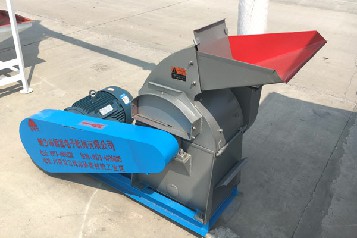
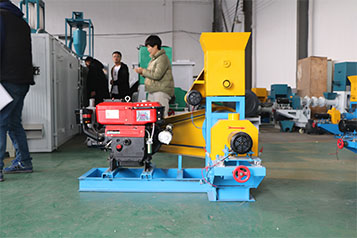
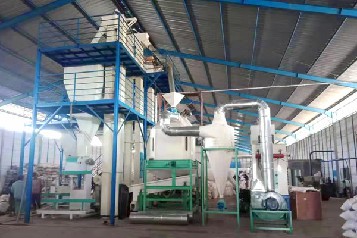
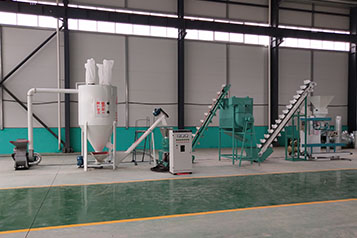
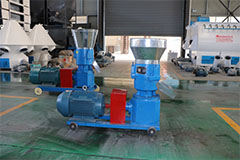


Leave your comment Here